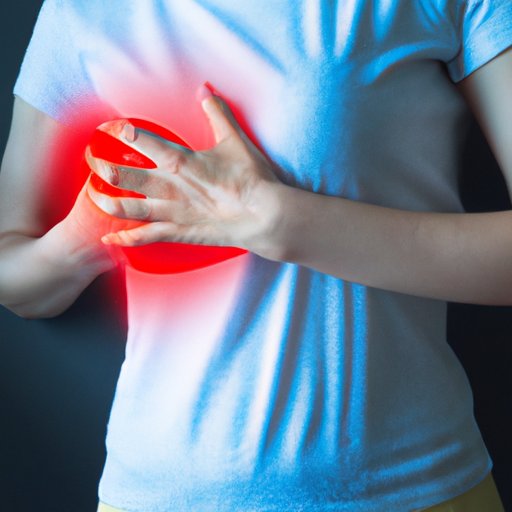Introduction
Angina is a type of chest pain or discomfort that occurs when the heart does not receive enough oxygen-rich blood. It is often caused by a narrowing of the coronary arteries, which supply the heart with oxygen-rich blood. Exercise can be beneficial for angina sufferers, as it can improve cardiovascular health, reduce stress levels, and increase strength and endurance. In this article, we will explore the potential benefits of exercise on angina symptoms and look at the evidence for using regular exercise as a treatment.

Exploring the Benefits of Exercise on Angina Symptoms
Exercise can help to improve cardiovascular health and reduce the risk of angina symptoms. Regular physical activity can help to strengthen the heart muscle and improve cardiovascular fitness. This can help to reduce the amount of work the heart has to do, which in turn can reduce the likelihood of angina occurring. Exercise can also help to reduce stress levels, which can further reduce the risk of angina symptoms.
In addition to improving cardiovascular health, exercise can also help to improve strength and endurance. Strength training can help to build muscle, which can help to reduce the workload on the heart. Endurance exercises such as walking, jogging, and cycling can help to improve the body’s ability to use oxygen, which can also reduce the risk of angina symptoms.
Exercising to Manage Angina: What You Need to Know
When exercising with angina, it is important to choose activities that are appropriate for your current level of fitness. Low-impact activities such as walking, swimming, and light strength training are generally recommended for people with angina. High-intensity activities such as running, sprinting, and heavy weightlifting should be avoided, as they can put too much strain on the heart.
It is also important to take safety precautions when exercising with angina. It is best to start off slowly and gradually increase the intensity of your workouts over time. It is also important to stay hydrated and avoid overexertion. If you experience any chest pain or discomfort during exercise, stop immediately and seek medical advice.
Can Regular Exercise Help Cure Angina?
Regular exercise can be beneficial for managing angina symptoms, but it is important to understand the limits of exercise. While exercise can help to improve cardiovascular health, reduce stress levels, and increase strength and endurance, it is not a cure for angina. The only way to cure angina is to treat the underlying cause, which is usually a narrowing of the coronary arteries.
However, regular exercise can help to prevent angina symptoms from occurring in the first place. Regular physical activity can help to reduce the risk of developing coronary artery disease, which is the most common cause of angina. Regular exercise can also help to maintain a healthy weight, which can further reduce the risk of angina.
Exercise for Angina: Is it an Effective Treatment?
There is evidence to suggest that exercise can be an effective treatment for angina. Studies have shown that regular physical activity can reduce the frequency and severity of angina symptoms. Regular exercise can also help to improve quality of life for angina sufferers. However, it is important to note that exercise should not be used as a substitute for traditional medical treatments for angina.
Other treatments for angina include medications, lifestyle changes, and surgery. Medications such as nitrates and beta-blockers can help to reduce the severity of angina symptoms. Lifestyle changes such as quitting smoking, eating a healthy diet, and reducing stress levels can also help to reduce the risk of angina. Surgery may be recommended in severe cases of angina, in order to widen the narrowed coronary arteries.

The Role of Exercise in Treating Angina
Exercise plays an important role in treating angina. Regular physical activity can help to improve cardiovascular health, reduce stress levels, and increase strength and endurance. It can also help to reduce the frequency and severity of angina episodes. However, it is important to understand the limits of exercise, and to remember that it is not a cure for angina.
If you have angina, it is important to talk to your doctor about developing an exercise plan that is tailored to your individual needs. Your doctor can help to determine what types of exercise are safe for you to do, and can help you to develop a plan that is safe and effective.

Understanding the Connection Between Exercise and Angina Relief
The connection between exercise and angina relief is clear. Regular physical activity can help to improve cardiovascular health, reduce stress levels, and increase strength and endurance. It can also help to reduce the frequency and severity of angina episodes. However, it is important to remember that exercise should not be used as a substitute for traditional medical treatments for angina.
In addition to exercising regularly, it is also important to adopt healthy lifestyle habits. Eating a balanced diet, quitting smoking, and reducing stress levels can all help to reduce the risk of angina. It is also important to monitor your angina symptoms and seek medical advice if they worsen.
Conclusion
In conclusion, exercise can be beneficial for angina sufferers, as it can help to improve cardiovascular health, reduce stress levels, and increase strength and endurance. Regular physical activity can also help to reduce the frequency and severity of angina episodes. However, it is important to understand the limits of exercise, and to remember that it is not a cure for angina. Adopting healthy lifestyle habits and monitoring angina symptoms can also help to reduce the risk of angina.


